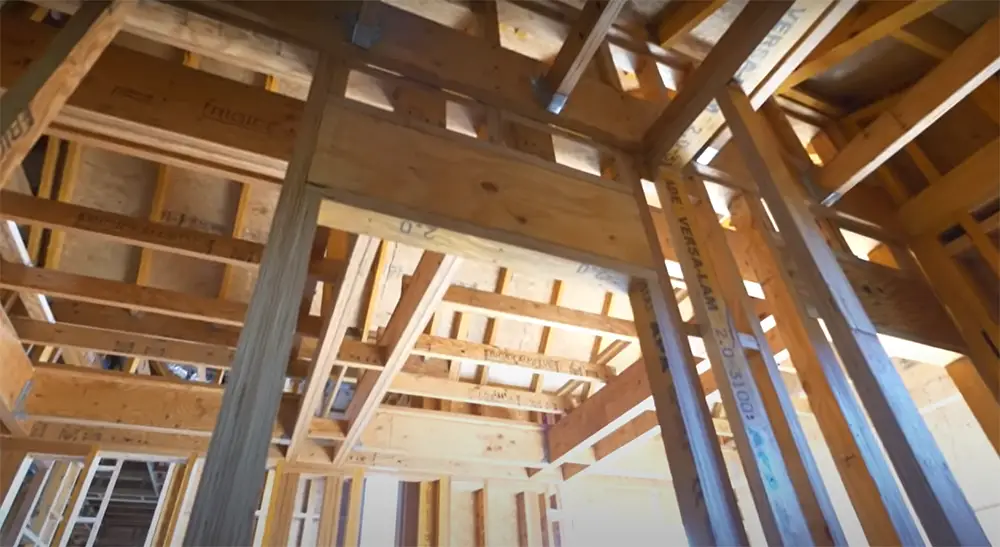How much weight can a second floor hold? That is a question that many homeowners ask themselves when they are considering expanding their home. The answer, of course, depends on a variety of factors, including the construction of the second floor and the weight of the objects being placed on it. In this comprehensive guide, we will answer common questions about the weight limits of a second floor and provide useful tips for ensuring your home can handle whatever you throw at it!
Why Knowing the Weight Capacity of Upper Floors is Important
Before we get into how much weight your second floor can hold, it’s important to understand why this information is critical. The weight capacity of any level in your home is a key factor in the stability and safety of your house.
The upper floors in particular are more susceptible to failure due to the increased amount of weight they must support. This is because the upper floors are not supported by the ground like the lower floors are. Instead, they rely on the strength of the walls and ceiling below them to stay up.
If you are planning on adding a second floor to your home, it is important to know how much weight the floor can hold. This will help you determine what type of materials to use in the construction of the floor and what size and weight of objects you can place on it. Additionally, if you already have a second floor in your home, understanding its weight capacity can help you avoid making any changes that could potentially damage the structure. [1]

There are a few reasons why homeowners might need to know the weight limit of their second floors:
- they are considering expanding their home by adding another level
- they want to be sure that their current second floor can handle any changes or additions they make to it
- they need to understand the weight capacity in order to make sure that their home is safe and stable
Now that we’ve gone over why it’s important to know the weight limit of your second floor, let’s talk about how much weight it can actually hold.
How To Calculate the Weight Limit a Second Floor Can Hold
There are a few different ways to calculate the weight limit of a second floor. The most common method is to use the dead load factor.
Dead Load and Live Load Factors
The dead load factor is the amount of weight that the floor must support without any additional loads being placed on it. This includes the weight of the materials used to construct the floor, as well as any furniture or other objects that will be placed on it.
The live load factor on other hand is the amount of weight that the floor must support when additional loads are placed on it. This could include things like people walking on the floor or heavy furniture being moved around.
The actual weight limit of your floor may be higher or lower depending on the materials used in its construction and the way it is supported. Due to this, most houses are designed with a certain amount of weight in mind. But over time, the weight capacity of a floor can change. This is usually due to things like water damage, termites, or other structural problems.
Span Tables

You can use span tables to determine how much weight your particular floor can hold. Simply find the table that corresponds to the materials you used in your floor’s construction and look up the appropriate value.
Another measurement that should be taken under consideration is the deflection limit. This is the amount that a floor can sag or bend before it becomes structurally unsound. The deflection limit for floors is usually around 1/360. This means that your floor should be able to support its own weight without sagging more than one- 360th of its length. [1], [2]
What is the Standard Weight Capacity For Second Floor
The standard weight capacity for a second floor is between 30 and 40 pounds per square foot. This means that your 100 square floor should be able to support between 3,000 and 4,000 pounds without any additional loads being placed on it.
Of course, as we mentioned before, the actual weight limit of your floor may be higher or lower depending on the materials used in its construction and the way it is supported.
It’s usually better to be cautious when it comes to floor weight limitations. This indicates that if you’re not sure about the strength of your flooring, you should seek expert assistance before making any modifications or additions. [1], [2], [3], [4], [5]
What Factors Affect the Weight Capacity of a Second Floor?
There are a few factors that affect the weight capacity of a second floor, including the type of foundation, the materials used in construction, and the soil conditions. The following sections will go into more detail about each of these factors.
Foundation
The type of foundation your home has will play a big role in how much weight the second floor can hold. For example, homes with slab foundations can typically hold more weight than those with crawl space or pier and beam foundations. This is because slab foundations are made of concrete, which is a very strong material. Crawl space and pier and beam foundations, on the other hand, are usually made out of wood, which is not as strong as concrete.
Soil Conditions
Another factor that affects the weight capacity of a second floor is the soil conditions. Homes that are built on soft soils, such as clay or sand, can typically hold less weight than those built on hard soils, such as gravel or bedrock. This is because soft soils are more likely to shift and settle over time, which can cause damage to the foundation and structure of the home.

Floor Joists
The floor joists are the beams that support the floor. They are usually made out of wood, but can also be made out of steel or concrete. The type of material used for the floor joists will affect the weight capacity of the floor. These two strips of joists run parallel to each other and are covered with additional floor layers. They impact how the base supports the weight in a safe manner. [1]
Negative Consequences of Putting Too Much Weight on Yours Second Floor
Risk of collapse
If you place too much weight on the second floor, it could collapse. This would cause serious damage to the structure of your home and it could injure people who are inside. In some cases, it could even be deadly.
Cracks in foundation
Another consequence of placing too much weight on the second floor is that it could cause the foundation to crack. This would weaken the support for the entire house and it could lead to further problems down the road.
Walls starting to bulge
If you put too much weight on the second floor, the walls may begin to bulge. Because the second floor’s weight is placing additional strain on the walls, this occurs. If this happens, the walls could collapse as a result of being under so much strain.
Floors starting to appear uneven
If the second floor is carrying too much weight, the floors may start to appear uneven. This happens because the extra weight on the second floor is causing the floors to sink in slightly. If this problem is not fixed, it could lead to serious structural issues.
Damage appearing on the floor beams
If the second floor is too heavy, it might cause the floor beams to fracture. This is because the additional weight would put more strain on the beams, putting them at risk of breaking or cracking.

So, as you can see, there are some serious consequences that come with placing too much weight on the second floor. It’s important to be aware of these risks before you make any decisions about how much weight your second floor can hold. [1], [2], [3], [4]
Tips on Placing Heavy Equipment on Your Second Floor
Taking care of the floor regularly
Another way to ensure the longevity of your second floor is by placing mats or rugs in high-traffic areas. This will help protect the floor from scratches and other damage that can occur over time.
Distributing the weight of placed equipment evenly
When you are placing heavy equipment on your second floor, it is important to distribute the weight evenly. By moving the most heavy pieces of equipment closer to the walls, you may reduce the possibilities of structural failures. This will help keep the weight balanced and prevent any one area from bearing too much strain. The center of your floor is the weakest area and it’s important to avoid placing heavy furniture on it.
It is also advised to place heavy equipment or furniture in areas with multiple joists or support beams. This will help to further distribute the weight and prevent any concentrated areas of strain.
But don’t concentrate on one area too much, as this could lead to other problems. It is important to have a balance between placing items evenly and not overloading any one area. [1], [2], [3], [4]
Comparison of Weight Capacity for Different Second Floor Structures
The weight capacity of a second floor depends on various factors such as the material used, the size of the joists, the spacing between the joists, and the type of support. This table compares the weight capacity of different second floor structures based on these factors.
| Second Floor Structure | Material | Joist Size | Joist Spacing | Type of Support | Weight Capacity |
|---|---|---|---|---|---|
| Wood Frame | 2×8 lumber | 8 inches | 16 inches on center | Load-bearing walls | 40-50 pounds per square foot |
| Steel Frame | Steel beams | 10 inches | 24 inches on center | Steel columns | 100-150 pounds per square foot |
| Concrete Slab | Reinforced concrete | N/A | N/A | Steel or concrete columns | 150-200 pounds per square foot |
The table compares the weight capacity of three different second floor structures: wood frame, steel frame, and concrete slab. The wood frame structure uses 2×8 lumber with an 8-inch joist size and 16-inch spacing between the joists. It is supported by load-bearing walls and can hold 40-50 pounds per square foot. The steel frame structure uses steel beams with a 10-inch joist size and 24-inch spacing between the joists. It is supported by steel columns and can hold 100-150 pounds per square foot. The concrete slab structure uses reinforced concrete and is supported by either steel or concrete columns. It has a weight capacity of 150-200 pounds per square foot. It is important to note that these weight capacities are approximate and can vary based on the specific design and construction of the structure.
Read more guides to improve your house:
- Can A Landlord Tell You How Clean To Keep Your House?
- How to Organize a Deep Pantry?
- How to Fix Steep Stairs Little Headroom?
FAQ
What is the weight limit for the second floor?
The answer to this question is not as simple as it seems. There are a variety of factors that can affect the weight limit of a second floor, including the type of foundation, the materials used in construction, and the load-bearing capacity of the framing.
However, most second stories in non-sleeping bedrooms can handle up to 40 pounds per square foot. Bedrooms have a lower capacity and can only handle up to 30 pounds per square foot. However, it is always best to contact an engineer or architect before doing so.
What will happen if I have too much weight upstairs?
If you have too much weight on the second floor, it could cause the floor to collapse. This is why it is so important to know the weight limit for your particular situation.
Overloading a second floor can also lead to other problems, such as cracked walls or ceilings, floors that are uneven or sagging, and doors that won’t close properly. All of these issues can be costly to repair, so it is best to avoid them if at all possible.
How to calculate floor load capacity?
The best way to measure the weight limit for your floor is to consult with an engineer or architect. They will be able to take into account all of the factors that can affect the weight limit, such as the type of foundation and the materials used in construction.
Once you have a good idea of the weight limit, you can then start planning how to distribute the weight evenly across the floor. This will help to prevent any problems in the future.
Can I build a home gym on the second floor?
Yes, you can build a home gym on the second floor, but you will need to be aware of the weight limit. You will also need to make sure that the floor is able to support the equipment that you plan on using.
Useful Video: Six Examples of How Second-Story Walls Are Supported – Structural Framing and Engineering
Conclusions
In conclusion, it is very important to know the weight limit for your second floor. You may need to measure the floor’s load capacity before you can make any decisions about how much weight it can hold.
You should also be wary of the hazards of concentrating too much weight on the second story. This includes the danger of collapse, cracked walls and ceilings, and flooring that is uneven or sagging. All of these issues might be costly to repair, so you’d want to avoid them if at all possible. You may help to keep your second floor in excellent condition for years by using these strategies. Thank you for taking the time to read this article!
References:
- https://johnnyholland.org/how-much-weight-can-a-second-floor-hold/
- https://www.hunker.com/13400811/how-to-calculate-floor-load-capacity
- https://apartmentnotes.com/how-much-weight-can-second-floor-apartment-hold/
- https://moviecultists.com/can-second-floor-hold-much-weight
- https://askinglot.com/how-much-weight-can-you-put-on-a-second-story-floor










As a homeowner, I’ve wondered about the weight limits of my second floor. When my wife and I bought our two-story home, we put most of our heavy furniture like the bed, dressers, and bookshelves upstairs. Over time, I became concerned that we were approaching or exceeding the load capacity, so I did some research. Most sources seem to agree that a standard floor can hold 30-50 lbs per square foot. Knowing the square footage and joist size, I was able to calculate that our second floor could safely hold about 1200 lbs before risking damage. This gave me peace of mind that we weren’t near the limit yet.
When my growing teenagers started spending all their time in their upstairs bedrooms, I got a bit nervous about the weight load on the second floor. With their furniture, TVs, computers plus their friends coming over, I imagined we might be approaching the limit of what the floor could handle. I checked with a contractor who inspected the joists and said that while the weight was more concentrated than ideal, the total load was still within a safe range for that part of the house. He gave me tips like distributing the weight more evenly and avoiding jumping or roughhousing upstairs.
As a contractor, I always inform clients about realistic weight limits for their second floors. Most older homes were built to handle 30-50 lbs per square foot. Newer construction with engineered joists can often accommodate heavier loads, but there are still limits. I recommend consulting professionals to calculate the maximum safe load based on joist size and spacing. Excess weight risks severe sagging or even floor collapse. I’ve seen the damage overloading can do over time. My advice is to err on the side of caution with second floors.
When my wife and I bought a fixer upper, the first project was reinforcing the creaky second floor. After measuring the joists, I found they were undersized for modern loads. We wanted to feel comfortable having guests upstairs so I sistered new joists alongside the old ones. Now the second floor feels rock solid and we can hold big parties with multiple people spread out upstairs with no worries. It was a worthwhile investment to bring the floor up to modern standards.
As a piano teacher, I have to be very mindful of weight limits whenever I transport my grand piano to students’ homes. Most houses built decades ago simply aren’t designed to hold 500+ lbs of concentrated weight in one spot like a piano creates. I always inspect the structure of the second floor and check for signs it can’t handle the load. More than once, I’ve had to suggest alternative spaces for the piano rather than risk damage to the clients’ home. It’s not worth ruining a floor just to have the perfect practice spot. Safety has to come first.
When we were renovating our master bedroom on the second floor, I wanted to install a big soaking tub in the bathroom. But the contractor advised against it due to the amount of weight that would add in one part of the floor. Instead, we opted for a lighter fiberglass tub and avoided any tile or stone surfaces. It was disappointing but better than adding hundreds of pounds in one corner of the upstairs. I realized the weight limits are there for good reason, and it’s smart to work within them.
As an insurance claims adjuster, I’ve seen the damage and lawsuits that can result from second story floors collapsing under extreme weight. Homeowners don’t realize the risks of overloading floors with too much weighted exercise equipment, safes, fish tanks, or other dense items. We had one policyholder put in an upstairs Jacuzzi without reinforcing the joists, which led to nearly the entire floor caving in. My advice is to have old floors inspected and only add substantial weight if they are properly reinforced first. Preventing collapses is far safer and cheaper than repairing them.
When installing hardwood floors upstairs, I learned a lot about weight limits. My contractor said the glue and nails had to penetrate the subfloor enough to securely hold each board down under foot traffic. And too much glue could add excessive weight that the joists weren’t designed for. It was a balancing act making sure the floors were durable without overweighting the structure. They explained how leaving some spaces between boards allows the floor to flex slightly under weight. It’s a common misconception that floors should feel completely solid. Some strategic give is by design.
When we bought a beautiful antique mahogany bed for our guest bedroom, I was thrilled with how it looked upstairs. But after a few weeks, we noticed the floor was sagging badly in that one spot. I had a contractor look at it, and he confirmed that old mahogany is extremely dense and heavy. Our 1920s floor joists just weren’t built for a few hundred pounds concentrated in one small area. Regretfully, we had to move the antique bed to a first floor bedroom instead and replace it with a lighter modern bed. It’s a bummer but better than a collapsed ceiling downstairs!